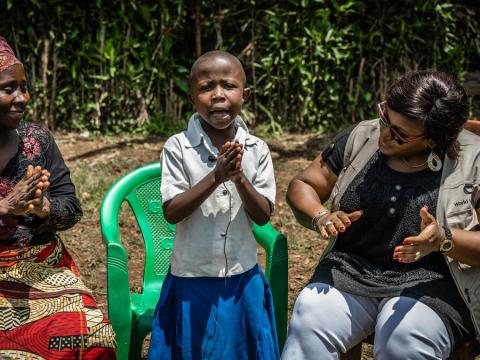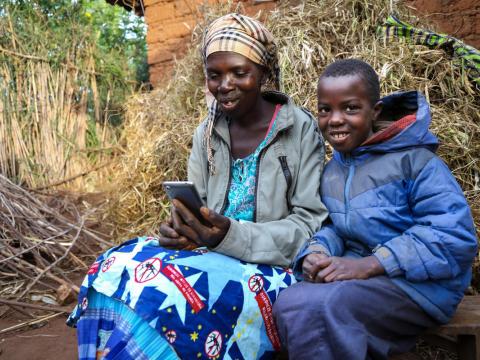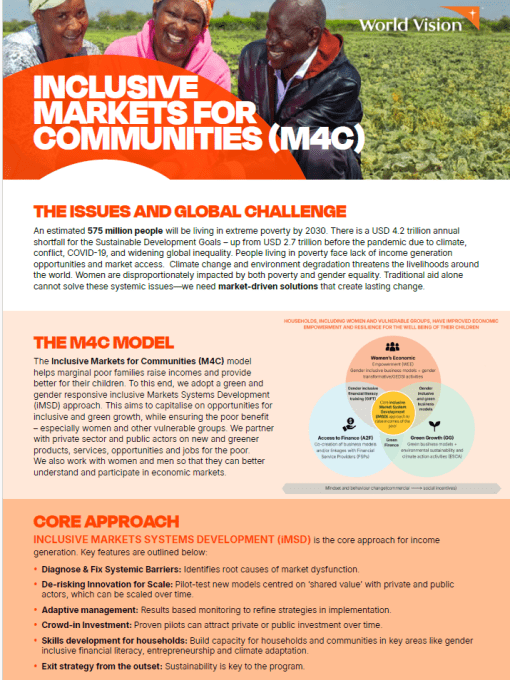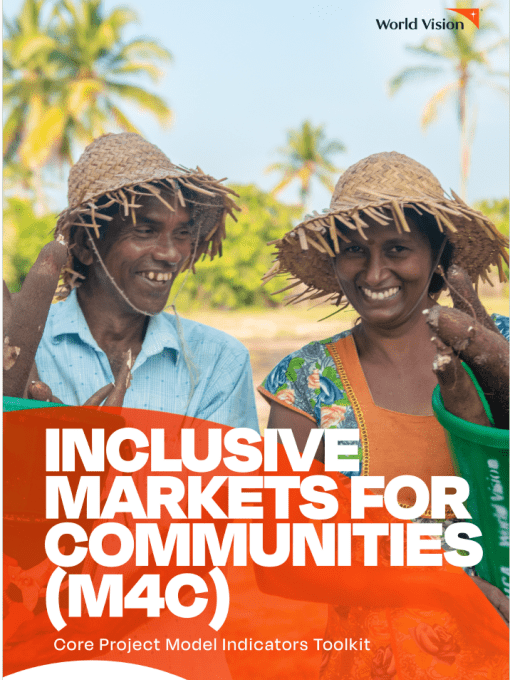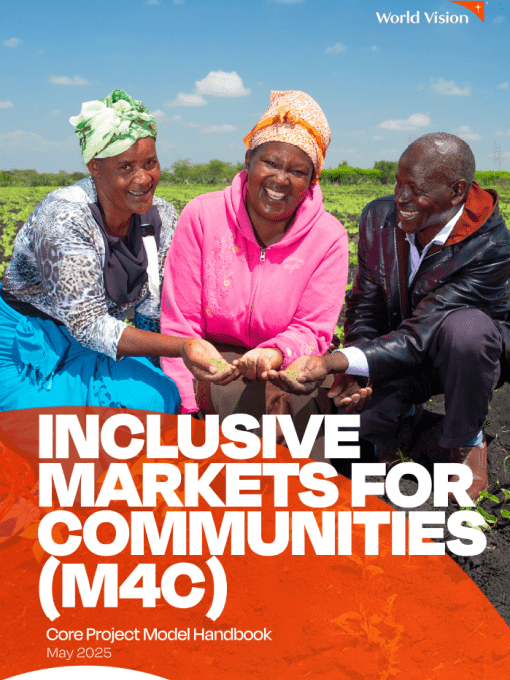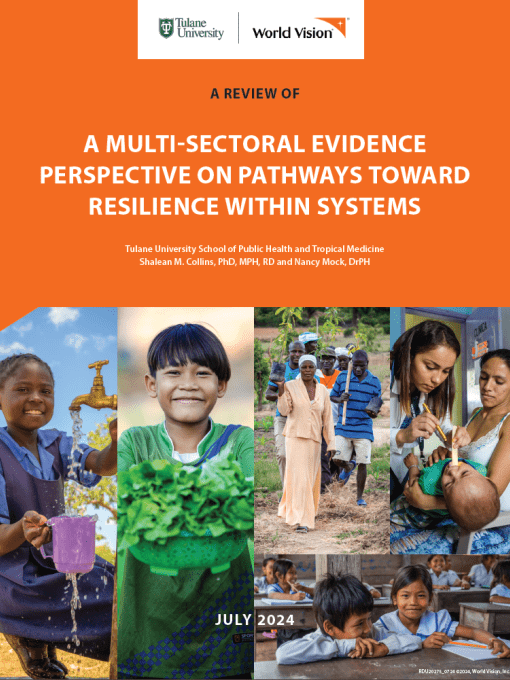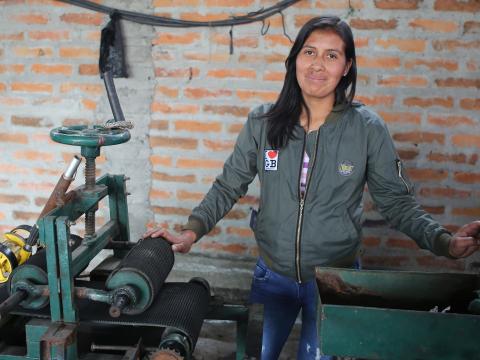
Livelihoods
Our Impact
Productive & Resilient Livelihoods
Around the world, the impact of extreme poverty on children’s development is devastating. Approximately 333 million children are living in extreme poverty with less than $2.15 a day.
Child poverty has long-term implications for their overall well-being. These include poor psychosocial and physical health, malnutrition, lack of education, social exclusion, and limited future employment opportunities. Children may be exposed to more violence, such as child labour and child marriage, as families and caregivers face economic difficulties. This is due to increased stress and pressure to make ends meet.
Predictions suggest that climate and disaster risk will push an estimated 325 million poor people into extreme poverty over the next decade. Children in the poorest and most fragile contexts face the greatest risk.
In alignment with the Sustainable Development Goals (SDG), World Vision strives to end poverty in all its forms by 2030 to help the most vulnerable children to reach their full potential. We do this by:
- Graduating the most vulnerable families out of extreme poverty – so that very poor families become economically self-reliant and have the dignity and means to provide for their own children.
- Strengthening food production and increasing resilience and access to markets and financial services – so that farmers can increase production of more sustainable and more nutritious food for household consumption and income-earning purposes.
- Promoting sustainable employment opportunities and market systems – so that communities have access to goods, services and employment opportunities through private sector partnerships.
- Promoting women’s economic empowerment – so that through economic advancement, women have access to opportunities, services, resources; and through agency, women gain improved decision-making in households and economic activities, and can manage their paid and unpaid workloads, resulting in improved wellbeing. World Vision also promotes equitable systems through which women can benefit from equitable policies, laws, institutional practices, and social norms.
Learn more about World Vision's Livelihoods programmatic approaches,
visit our Livelihoods Technical Library,
or contact us at livelihoods@wvi.org.
Our Approaches
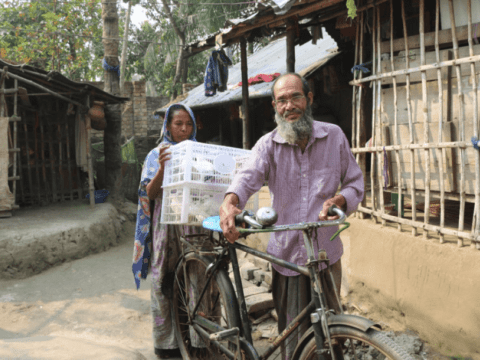
Ultra Poor Graduation
Our intensive two-year programme called ‘Ultra-poor Graduation’ (UPG) equips the most vulnerable families to be self-reliant once World Vision has moved on to help others. We provide access to temporary food and cash assistance, savings for transformation, training, and marketing expertise to help families’ kickstart a small business or access employment. Families also learn about health, nutrition, and hygiene practices to ensure that economic gains are translated into better care for their children.

Inclusive Markets for Communities
The Inclusive Markets for Communities (M4C) model helps marginal poor families raise incomes and provide better for their children. To this end, we adopt a green and gender responsive inclusive Markets Systems Development (iMSD) approach. This aims to capitalise on opportunities for inclusive and green growth, while ensuring the poor benefit – especially women and other vulnerable groups. We partner with private sector and public actors on new and greener products, services, opportunities and jobs for the poor. We also work with women and men so that they can better understand and participate in economic markets.
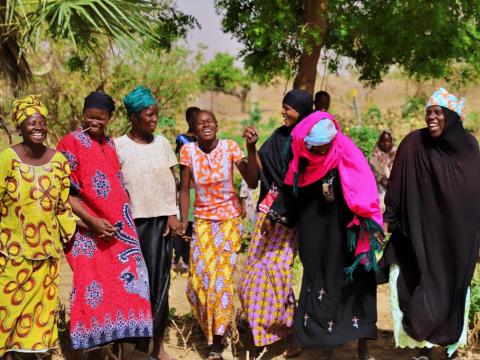
Savings for Transformation
Savings for Transformation (S4T) is an approach being used by over six million active participants, many of whom are women, to facilitate savings and credit in a small-scale and sustainable way. S4T instils hope and contributes to child well-being by enabling community members to plan ahead, cope with household emergencies, develop their livelihoods and invest in the health and education of their children.
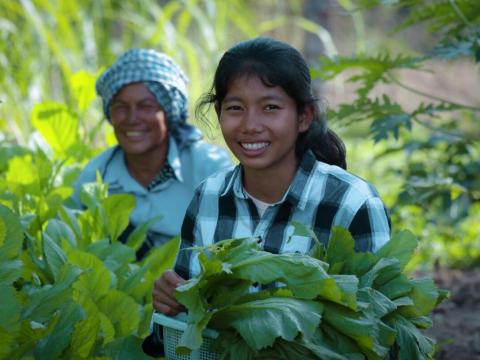
Microfinance
We work with community members to develop relevant skills for them to bring into the workplace. This not only provides a potential and sustainable livelihood for the future but also instils hope and aspirations for a better life. Our microfinance arm, VisionFund, works with potential employers by providing small loans to promote market and employment opportunities.
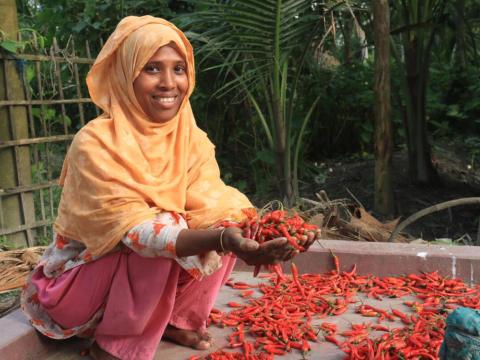
Women's Economic Empowerment
When women are stable financial contributors to a household, investments in children's health and education increase.
Livelihoods Frequently Asked Questions (FAQs)
What does “livelihoods” mean in the context of World Vision’s work?
In simple terms, a livelihood is how someone earns a living and secures the essentials of life—like food, shelter, clothing, healthcare, and education. A sustainable livelihood means families can cope with challenges—like economic shocks or natural disasters—and recover without falling deeper into poverty.
At World Vision, where our work centres on improving the well-being of children, livelihoods are about helping caregivers provide these necessities in a reliable and sustainable way. When caregivers have fewer financial worries, household stress is reduced, which benefits children’s emotional and physical well-being. Strong livelihoods also support community development. As families become more stable, they can contribute to improvements like better schools, clean water systems, safe playgrounds, and other resources that help children and communities thrive.
Why is supporting livelihoods important for sustainable development?
Supporting livelihoods is critical for sustainable development because it empowers households to meet their basic needs, build resilience, and break the cycle of poverty. When families have secure and diverse livelihoods - through farming, livestock, small businesses, or other means - they can invest in education, health, and nutrition for their children. This not only improves individual well-being but also strengthens communities, reduces vulnerability to shocks, and fosters economic growth.
Sustainable livelihoods also promote responsible resource use and environmental stewardship, ensuring that development benefits both current and future generations.
What are the main challenges people face in securing stable livelihoods?
Conventionally, the challenges to securing stable livelihoods are multifaceted, involving external factors such as economic, social, environmental, and systemic, and internal factors such as poverty mindsets. Economic constraints like low income, limited access to markets, financial services, and productive assets restrict investment in sustainable activities. Social barriers, including gender inequality, marginalisation, and weak networks, limit participation in income-generating opportunities, while environmental threats such as climate variability and land degradation undermine productivity.
Systemic challenges, including weak governance and inadequate infrastructure, further restrict access to markets and services. The poverty mindset, shaped by prolonged deprivation, can reduce initiative, favour immediate needs over long-term goals, and prevent people from seizing opportunities even when external constraints are addressed. World Vision’s livelihoods approaches, therefore, address both external vulnerabilities and internal mindsets to foster sustainable change.
People face a wide range of challenges when trying to secure stable livelihoods. These challenges can be both external and internal:
- Economic barriers: Low income, limited access to markets, financial services, and productive assets make it difficult for families to invest in sustainable livelihood activities.
- Social barriers: Gender inequality, marginalisation, and weak social networks can prevent people from participating in income-generating opportunities.
- Environmental threats: Climate change, unpredictable weather, and land degradation reduce productivity and threaten long-term stability.
- Systemic issues: Poor infrastructure, weak governance, and limited access to essential services and markets further restrict opportunities.
- Internal factors: A “poverty mindset,” shaped by long-term deprivation, can lead people to focus only on immediate survival needs, making it harder to plan for the future or take advantage of new opportunities.
World Vision’s livelihoods approach addresses both the external vulnerabilities and the internal barriers. By building skills, strengthening systems, and supporting mindset shifts, we help families and communities move toward long-term, sustainable change.
How do livelihoods programmes help reduce poverty and inequality?
World Vision’s livelihoods programmes reduce poverty and inequality by strengthening household income, food security, and resilience. They promote financial inclusion, asset building, and risk management, while supporting diverse, context-appropriate livelihood options. Programmes are designed with communities and tailored to local systems, ensuring sustainability and equity. By addressing structural barriers and enabling access to markets and services, livelihoods programmes help families transition from vulnerability to self-reliance.
Over time, this promotes inclusive economic development by reducing income gaps, and strengthening local economies where prosperity is shared more evenly.
Do World Vision livelihoods programmes focus on rural, urban, or both types of communities?
Over the many years that World Vision has been serving the poor and vulnerable across the world, we have recognised that often the children of these communities are in rural and remote areas. But not always and not everywhere.
As the world has witnessed more of the rural poor drift to urban areas looking for opportunity and services, World Vision has seen the need to change its approach to journey with households and communities that are not working or living from the land but face deprivation and disadvantage in urban and peri-urban situations. This has meant that, in some circumstances and contexts, World Vision has shifted from a rural focus to more urban. This has brought new challenges and the need for different and contextually appropriate responses.
What types of livelihood support does World Vision provide?
Through trial and testing, World Vision has created a set of evidence-based models and methodologies that represent best practices in livelihood development. The Core Project Models (CPMs) lay out approaches that have proven to result in positive outcomes for the participating individuals, their households and their communities. The four Livelihoods CPMs of Inclusive Markets for Communities (M4C), Savings for Transformation (S4T), Ultra Poor Graduation (UPG) and Microfinance (MF) provide implementers and development practitioners the tools to journey with households to become more resilient and self-reliant.
Two of the models (M4C and MF) could be described as frameworks because of their broad approach and contextual adaptability. S4T and UPG are more specific in their methodology but can be applied almost anywhere and produce universally positive outcomes. These models are overseen and supported by the World Vision International Livelihoods team, who update, adjust, advise and train in each of the models.
How does World Vision tailor livelihoods programmes to local contexts, economies and cultures?
World Vision customises its livelihoods programmes through participatory assessments that identify household vulnerabilities, community priorities, and gaps and opportunities in physical, social, policy, and market systems. The findings are used to deliver context-specific skills training, asset transfers, financial inclusion, market linkages, and resilience support. Evidence-based Core Project Models (CPMs) like Saving for Transformation (S4T), Ultra-Poor Graduation (UPG), and Inclusive Market for Communities (M4C) are adapted to poverty levels, community fragility, and urban or rural contexts, with UPG supporting the extremely poor and M4C integrating the transient poor into market systems.
Fragile rural areas may require food security and agricultural support, while urban settings emphasise small businesses and vocational skills. Complementary non-livelihood models address cultural and social barriers, engaging leaders to promote positive norms through tools such as Empowered Worldview and Citizen Voice and Action, an accountability model that ensures the power balance between citizens, service providers and the government.
How do World Vision livelihoods programmes support specific groups such as women, youth, or people with disabilities?
World Vision is a child-focused organisation, meaning increased child wellbeing is World Vision's primary objective. Because individuals, households and communities care for children, it is appropriate that livelihoods programmes are fully inclusive and support and empower the adults who are responsible for children. Some of the most disadvantaged households are those where carers are women and or where there are people with disabilities. It is therefore important that World Vision programmes are appropriately adaptable so that women and people with disabilities can engage fully.
Evidence also shows that when the adult women in a household are engaged in economic development, children of the household are more likely to be direct beneficiaries. All livelihoods programmes are, by design, inclusive and have scope to be able to be adapted to meet the needs of these specific groups.
How does World Vision ensure the sustainability of income-generating activities?
World Vision ensures the sustainability of income-generating activities by supporting communities to lift productivity, build strong local markets and improve access to financial services like microfinance and savings groups. We also support people to develop practical skills and knowledge so they can identify business opportunities that suit their strengths and local context. Our approach promotes environmentally friendly and gender-inclusive businesses, and we work closely with communities and with public and private sector actors to make sure these efforts lead to lasting economic growth.
What is the relevance of livelihoods programmes to food security and how are livelihoods programmes linked to food systems?
Food security is a primary outcome of sustainable livelihoods. People’s capabilities, assets, and activities needed to make a living, withstand shocks, and sustain themselves without depleting natural resources are all part of their sustainable livelihoods. One of the outcomes is food security, when all people, at all times, have physical, social, and economic access to sufficient, safe, and nutritious food that meets their dietary needs and food preferences for an active and healthy life (FAO, 1996 World Food Summit definition).
In addition, Livelihood programmes enable vulnerable populations to contribute to and benefit from food systems through various interventions such as food production, market linkages, financial inclusion, off-farm and non-farm income generation, resilience and sustainability, etc. In that way, livelihood programmes are an integral part of strengthening and transforming food systems, contributing to the networks of people, activities, resources, and institutions involved in producing, processing, distributing, consuming, and disposing of food, and how these systems affect health, environment, and society.
With World Vision’s focus on the wellbeing of children, what is the contribution of livelihoods programmes to the wellbeing of children?
Sustainable livelihoods are essential to the well-being of children. The income earned enables caregivers to provide all the practical items that children need such as adequate clothing and shoes, education, and nutritious food. Beyond income, livelihoods encompass diverse strategies and resources- such as farming, livestock rearing, small businesses and community support- that help households meet their needs and build resilience.
With sustainable livelihoods, money can also be available for community investment to ensure, for example, that clean water is available for children, that girls have private latrines at school, and that all children have a safe place to play. With a secure and sustainable livelihood, caregivers can plan for their children's future, breaking the cycle of poverty, and giving hope to future generations.
With World Vision's focus on fragile contexts and rural communities, livelihoods are often tied to agriculture, including both crop production and livestock. The well-being of children depends upon their sustainable agricultural practices to ensure that children have a healthy environment in which to thrive and to inherit in the future.
What learning resources are available to deepen our collective expertise in livelihoods programming?
Dive deeper into the WVCentral Livelihoods Core Project Models page to find resources, reports and tools. You may also enrol on the livelihoods e-workshops to build your technical expertise in implementing the core project models and approaches.


